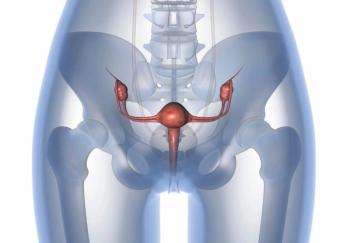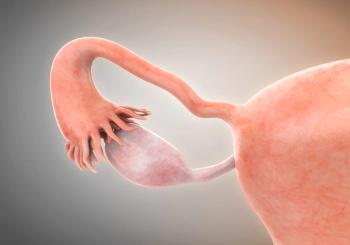
- ONCOLOGY Vol 12 No 6
- Volume 12
- Issue 6
Salvage Therapy for Ovarian Cancer
As Drs. Sabbatini and Spriggs point out in their review, the majority of ovarian cancer patients continue to present with advanced-stage disease, and only a minority are cured after primary surgery and chemotherapy. At present, recurrent disease is best viewed as a chronic illness that requires ongoing management. A number of therapeutic options are available, but opportunities for cure remain limited. My comments will focus on post-remission therapy, small-volume residual disease, intraperitoneal therapy, secondary cytoreductive surgery, choice of second-line chemotherapy, and participation in phase II studies.
As Drs. Sabbatini and Spriggs point out in their review, the majority of ovarian cancer patients continue to present with advanced-stage disease, and only a minority are cured after primary surgery and chemotherapy. At present, recurrent disease is best viewed as a chronic illness that requires ongoing management. A number of therapeutic options are available, but opportunities for cure remain limited. My comments will focus on post-remission therapy, small-volume residual disease, intraperitoneal therapy, secondary cytoreductive surgery, choice of second-line chemotherapy, and participation in phase II studies.
Post-Remission Therapy
The framework employed by the authors for classifying refractory, persistent, and recurrent disease is useful. The schema could be broadened to include patients in clinical and pathologic complete remission, as we know that the majority of these individuals harbor residual microscopic disease and will eventually relapse. Clinical trials have not yet documented the efficacy of additional intraperitoneal or systemic chemotherapy in this setting.
In an example from Memorial Sloan-Kettering Cancer Center (MSKCC) cited by the authors, the use of intraperitoneal cisplatin (Platinol) and etoposide following negative second-look laparotomy reportedly improved disease-free survival, as compared with concurrent historical controls.[1] Confounding variables in this analysis include selection bias and a reduced frequency of paclitaxel (Taxol)-containing therapy in the controls. In addition, variations in the monitoring for recurrent disease, including serum CA-125, could have led to differences in the estimation of disease-free survival. Overall survival would be a more objective end point but probably would not be convincing in the absence of a randomized trial. Without more compelling data, this remains an interesting pilot study that has not changed routine clinical practice.
Results from a randomized trial of intraperitoneal phosphorus-32 (32P) in patients with negative second-look laparotomy are pending, and the current randomized trial sponsored by the Gynecologic Oncology Group (GOG) and Southwest Oncology Group (SWOG) is evaluating the role of intraperitoneal interferon-alfa (Intron A, Roferon-A), based on encouraging results in patients with small-volume residual disease.[2] This is an important study, but it will be difficult to complete due to the declining rate of second-look laparotomy.
Small-Volume Residual Disease
Although microscopic or small-volume residual disease would appear to be a good target for intraperitoneal chemotherapy, the role of primary or secondary intraperitoneal therapy has not been established. The authors quote the inverse relationship between tumor size and survival observed in the intergroup randomized trial of primary intraperitoneal vs intravenous therapy (GOG-104).[3] However, this size-related survival advantage was seen in both arms of the trial. No additional impact of intraperitoneal therapy on survival was detected in patients with microscopic or small-volume disease, who would have been predicted to show maximal benefit due to restricted drug penetration, although the study did not have sufficient statistical power to reveal small differences uncoverd by subset analysis.
The value of primary therapy with intraperitoneal cisplatin remains unclear, and the use of intravenous therapy with carboplatin (Paraplatin) and paclitaxel remains prevalent in the community. Data from a recently completed randomized trial that includes intraperitoneal cisplatin and intravenous paclitaxel (GOG-114) are awaited, and this question will be addressed further in a new GOG trial comparing intravenous and intraperitoneal paclitaxel. Unfortunately, there are no randomized trials planned that will evaluate secondary intraperitoneal chemotherapy in patients with recurrent or persistent disease.
Assessment of residual disease by laparotomy can be imprecise. In particular, it is not always clear which patients are in the midst of an ongoing tumor response and, thus, may benefit from further therapy, and which have already developed drug-resistant disease. Also, a small number of patients with microscopic residual disease have achieved pathologic remission at third-look laparotomy without intervening chemotherapy, suggesting that not all residual disease may be clonogenic.
Finally, from a purely technical perspective, the increased incidence of adhesions and loculations can restrict peritoneal access in patients with recurrent disease and/or multiple prior surgical procedures. Ultimately, intraperi- toneal therapy may be more successful with immunologic approaches, such as regulatory cytokines or vaccines, that do not depend on direct tumor contact to mediate indirect antitumor effects.
Investigators at MSKCC have conducted several nonrandomized phase II studies to evaluate second-line therapy in ovarian cancer. Although these studies show encouraging results in comparison to historical controls, it is important to remember that randomized phase III trials are needed to answer many of the questions that have been raised by these pilot data. For example, the authors report that a small number of patients have remained disease-free after achieving pathologic complete remission following intraperitoneal cisplatin.[4] However, long-term disease-free survival has also been observed in patients with small-volume disease who received intraperitoneal interleukin-2 (Proleukin)[5] and interferon-alfa.[2] Other phase II studies have failed to show an advantage for consolidation with intraperitoneal cisplatin after primary systemic therapy, suggesting that only a highly selected minority may benefit from this approach.[6]
The optimal management of small-volume persistent disease following initial therapy with platinum and paclitaxel remains unclear. As previously mentioned, reassessment laparotomy is generally unable to accurately distinguish drug-resistant residual disease from sensitive disease or nonclonogenic tumor remnants. However, there is a hypothesis that some patients with responsive disease may benefit from high-dose consolidation--a question that cannot be resolved with additional phase II studies.
Although hampered by poor initial accrual, GOG-164 is a phase III randomized trial that aims to evaluate high-dose therapy with stem-cell support following response to initial chemotherapy. Recent amendments to broaden eligibility criteria should improve physician acceptance and patient accrual to this important study, but it remains to be determined whether there will be adequate accrual to satisfy the study objectives in a timely fashion. I agree with the authors that there is no role for dose-intensive therapy in patients with persistent disease outside of a clinical trial.
Secondary Cytoreductive Therapy
The authors refer to secondary cytoreductive surgery in the context of recurrent platinum-sensitive disease. Certainly, some patients with a platinum-sensitive recurrence may derive palliative benefit from surgery. However, this group of patients can also benefit from chemotherapy, and usually harbor additional sites of disease. Once again, recommendations suffer from a lack of data, particularly from phase III randomized trials.
As we learn more about tumor invasion,[7] angiogenesis,[8] and adhesion molecules,[9] it may become possible to predict outcome on the basis of tumor biology, rather than the technical ability to perform debulking surgery. It would be appealing to design a phase III study of initial vs delayed cytoreductive surgery with assessment of biological markers and clinical end points. Thus far, physician bias has prevented the development of such a trial for the management of either initial or recurrent disease. In the minority of patients who present with solitary or regional recurrence, secondary cytoreductive surgery or radiation may provide palliative benefit but would be unlikely to substantially improve overall survival.
Choice of Second-Line Chemotherapy
Many options exist for systemic management of recurrent disease following initial response to chemotherapy. The use of platinum, paclitaxel, topotecan (Hycamtin), gemcitabine (Gemzar), liposomal doxorubicin (Doxil), prolonged oral etoposide, vinorelbine (Navelbine), and other agents are discussed in detail by the authors. Choices among these different therapies are guided largely by physician and patient preference and issues of convenience or cost.
Regardless of the therapy chosen, it is important to monitor tumor response so that alternative therapies can be considered prior to excessive deterioration in vital organ function or performance status. In the absence of dose-limiting toxicity or tumor progression, patients should remain on their current therapy. Stable disease is a common and acceptable outcome in this palliative setting. Some agents, such as topotecan and paclitaxel, offer little cumulative toxicity and can be safely administered over multiple cycles to patients with stable disease.
Participation in Phase II Studies
Careful consideration should be given to current phase II studies, which aim to define new agents and optimize the use of established agents. Although patients with a prolonged disease-free interval have an increased likelihood of responding to platinum-based therapy, platinum will not be curative in this population, and other standard or investigational therapy can be safely used prior to retreatment with platinum. Of note, prolongation of the platinum-free interval with non-platinum-based therapy can restore platinum sensitivity in some patients with previously documented platinum-resistant disease.[10] Thus, it is appropriate to defer platinum therapy and consider participation in clinical trials even for patients with platinum-sensitive disease.
There is no role for dose-intensive therapy in the setting of recurrent disease. Randomized trials evaluating more aggressive regimens, such as higher doses of paclitaxel, have reported a modest increase in response rates but no improvement in progression-free interval or survival.[11] Single agents should be used at standard doses and schedules, with adjustments based on patient tolerance. The primary goal in this setting is control of disease and maintenance of quality of life, not maximal tumor shrinkage. Hematopoietic growth factors should not be routinely used or required for maintenance of dose intensity, although erythropoietin (Epogen, Procrit) might be considered to reduce the frequency of blood transfusions in heavily pretreated patients receiving multiple cycles of marrow-suppressive therapy, such as topotecan.
In the palliative setting, where platinum resistance is common, it is unclear whether combinations offer any advantage over single agents. One randomized phase II study favored the use of a platinum-based combination over single-agent paclitaxel, but this study has been presented only in abstract form.[12]
There is certainly an increased risk of toxicity from combinations, and it is not always possible to determine which drug is responsible for clinical response or toxicity. However, preclinical models have suggested that some combinations may offer synergy, such as the use of either gemcitabine or topotecan with cisplatin, or topotecan followed in sequence by etoposide. These and other combinations are under evaluation in phase I/II trials. Outside of a clinical trial, I would favor the use of single agents, unless the patient has had a prolonged disease-free interval of more than 2 years.
Summary
The authors have written a thoughtful review of second-line therapy, drawing on their extensive experience with phase I/II trials at MSKCC. This provides a useful framework for clinical decision-making in patients with ovarian cancer. Again, emphasis should be placed on greater patient participation in clinical trials to define more active regimens for primary therapy. This is of particular importance in view of the diverse chemotherapeutic agents that have been found to be active in this setting.
Articles in this issue
over 27 years ago
Radiofrequency Waves Used to Kill Inoperable Liver Tumorsover 27 years ago
ONS Receives Educational Grants to Fund Conferencesover 27 years ago
Women’s Dissatisfaction With Body Image Can Affect Smokingover 27 years ago
M. D. Anderson Initiates Aggressive Ovarian Cancer Screening Programover 27 years ago
Gene May Provide Specific Target For Attacking Prostate Cancerover 27 years ago
Medicare Now Reimburses Cancer Patients for Granisetron TabletsNewsletter
Stay up to date on recent advances in the multidisciplinary approach to cancer.

















































































